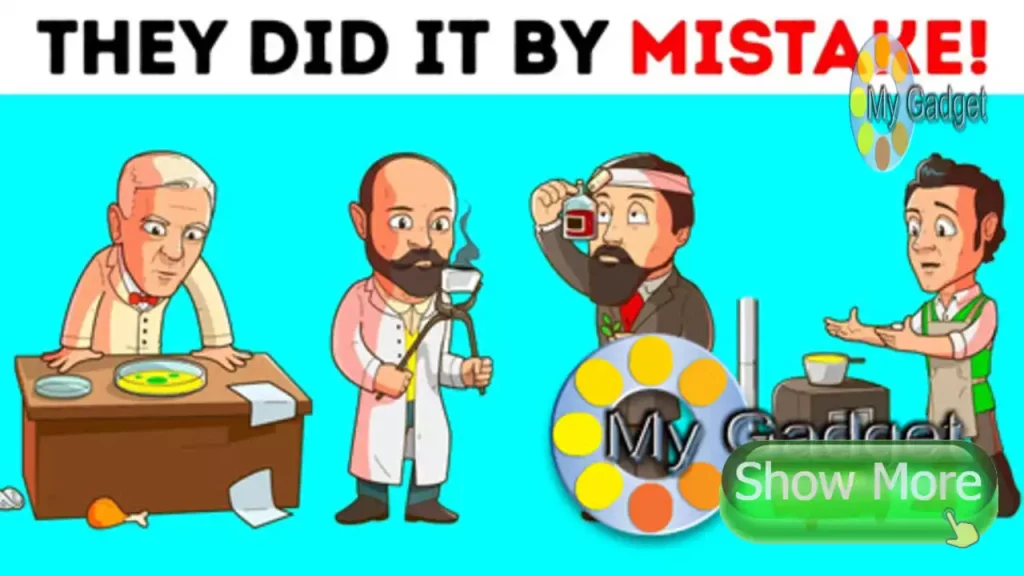Accidental Inventions
Throughout history, some of the most revolutionary inventions have emerged from unexpected circumstances, transforming everyday life in ways their creators never envisioned.
“Accidental Gadget Inventions” explores the fascinating stories behind these seemingly serendipitous innovations, highlighting how chance encounters, experimental mishaps, and unintended uses of materials have led to groundbreaking technological advancements.
From the creation of the microwave oven—initially discovered when a scientist noticed a chocolate bar melting in his pocket—to the invention of Post-it Notes, which arose from a failed attempt to create a super-strong adhesive, these gadgets exemplify how creativity and curiosity can flourish in the face of unpredicted outcomes.
This article delves into the journeys of these inventions, examining the key moments that spurred their development and the individuals behind them.
By understanding the nature of these accidental discoveries, we can appreciate the unpredictable path of innovation and the importance of remaining open to new possibilities.
As we chronicle the remarkable tales of these gadgets, we invite readers to reflect on the role of chance in the creative process and consider how seemingly insignificant events can lead to monumental changes in technology and society.
Table of Contents Accidental Inventions
3M launched the product as “Press ‘n Peel” in stores in four cities in 1977
But results were disappointing.
A year later 3M instead issued free samples directly to consumers in Boise, Idaho, with 94 percent of those who tried them indicating they would buy the product.
On April 6, 1980, “Press ‘n Peel” was re-introduced in US stores as “Post-It Notes”.
The following year they were launched in Canada and Europe. In 2003, the company came out with “Post-it Brand Super Sticky Notes”, with a stronger glue that adheres better to vertical and non-smooth surfaces.
Until 3M’s patent expired in the 1990s, post-it type notes were produced only in the company’s plant in Cynthiana, Kentucky.
In 1977, 3M initially introduced the product as Press ‘n Peel in select cities.
However, the outcome was disappointing. To turn things around, a year later, 3M decided to distribute free samples directly to consumers in Boise, Idaho.
The response was overwhelmingly positive, with 94 percent of the recipients expressing an intention to purchase the product.
Capitalizing on this feedback, on April 6, 1980, Press ‘n Peel was rebranded and relaunched as Post-It Notes in stores across the United States.
Following its success, the product expanded its reach to Canada and Europe the following year. Moreover, in 2003, 3M introduced Post-it Brand Super Sticky Notes, featuring a more adhesive glue that effectively sticks to vertical and non-smooth surfaces.
Prior to the expiration of 3M’s patent in the 1990s, post-it type notes were exclusively manufactured in the company’s Cynthiana, Kentucky plant.
The non-toxic, non-staining, reusable modeling compound
that came to be known as “Play-Doh” was originally a pliable, putty-like substance concocted by Noah McVicker of Cincinnati-based soap manufacturer Kutol Products; it was devised at the request of Kroger Grocery, which wanted a product that could clean coal residue from wallpaper.
Following World War II, with the transition from coal-based home heating to natural gas and the resulting decrease in internal soot, and the introduction of washable vinyl-based wallpaper, the market for wallpaper cleaning putty decreased substantially.
McVicker’s nephew, Joe McVicker, joined Kutol with the remit to save the company from bankruptcy; he subsequently discovered that the wallpaper cleaner was being used by nursery school children to make Christmas ornaments.
Post-it Notes originated from failed adhesive experiments in 1968, revolutionizing office organization
The development of Post-it Notes can be traced back to a series of adhesive experiments conducted by Dr.
Spencer Silver at 3M in 1968.
Rather than achieving a strong bond, Silver inadvertently created a pressure-sensitive adhesive that was easy to reposition.
Initially, this invention did not garner significant interest, as it did not fulfill any immediate market need.
However, in 1974, another 3M employee, Art Fry, recognized the potential of Silver’s adhesive while trying to find a solution for bookmarking his hymnal without damaging the pages.
This realization led to the creation of a new product that would not only be practical for personal organization but also transform workplace dynamics.
Upon its introduction to the market in 1980, Post-it Notes quickly gained popularity for their versatility and functionality.
They enabled users to jot down reminders, share messages, and organize thoughts in a simple yet effective manner.
This innovation revolutionized office organization by promoting a more dynamic and interactive approach to communication, allowing for better collaboration and efficiency.
The impact of Post-it Notes extends beyond traditional office settings, as they have become an essential tool in educational environments and personal organization, showcasing the power of creativity and adaptability in product development.
The microwave was discovered accidentally while testing radar technology during World War II
During World War II, researchers were exploring radar technology when they stumbled upon a revolutionary method of cooking food.
While working with magnetrons, devices that generate microwave radiation, an engineer named Percy Spencer noticed that a chocolate bar in his pocket had melted due to the emitted waves.
Intrigued by this unexpected phenomenon, Spencer began experimenting with other food items, ultimately discovering that microwaves could cook food quickly and efficiently.
This serendipitous discovery led to the development of the first microwave oven, transforming culinary practices in homes and commercial kitchens alike.
By the 1950s, the technology was adapted for consumer use, paving the way for a kitchen appliance that would alter meal preparation forever.
The microwave oven not only demonstrated the innovative potential of radar technology in everyday life but also became a staple in modern cooking, illustrating how unanticipated discoveries can lead to significant advancements.
Play-Doh was initially created as a wallpaper cleaner before becoming a beloved children’s toy
Originally developed as a wallpaper cleaner in the 1930s, the substance now known as Play-Doh was designed to remove soot and dirt from walls.
The malleable mixture of flour, water, salt, and other ingredients proved effective for its intended purpose, but as its popularity grew, its creators recognized an opportunity for broader applications.
In the 1950s, the product was rebranded and marketed as a children’s modeling compound, capitalizing on its safe and non-toxic nature.
This strategic pivot not only introduced Play-Doh to a new generation of young creators but also established it as a timeless tool for imaginative play.
As a result, what began as a utilitarian cleaning product evolved into a cherished toy that encourages creativity and artistic expression, illustrating how innovative repurposing can lead to enduring success in the consumer market.
The slinky was invented when a metal spring fell off a shelf and danced
The creation of the slinky is attributed to a moment of serendipity when a metal spring fell from a shelf and exhibited an unexpected, lively movement that captured the attention of its inventor, Richard James.
This simple yet captivating behavior sparked an idea: to harness the spring’s potential for entertainment.
Recognizing its unique ability to “walk” down stairs and perform various tricks, James began to refine the design and market it as a toy.
By the early 1940s, the slinky was introduced to the public, quickly gaining popularity as a playful gadget that delighted children and adults alike.
Its charm lies not only in its kinetic properties but also in its ability to engage users in creative play.
The slinky exemplifies how an unforeseen incident can pave the way for innovative products, transforming everyday materials into sources of joy and inspiration.
Super Glue was developed accidentally while attempting to make a clear plastic for weapons
In the quest to develop a clear plastic for use in weaponry during World War II, chemist Harry Coover stumbled upon a remarkable adhesive that would later be known as Super Glue, or cyanoacrylate.
During his experiments, Coover discovered that the substance he created exhibited an extraordinary ability to bond materials almost instantaneously.
Although his initial focus was on creating a transparent plastic, the unexpected properties of the adhesive prompted further investigation and refinement.
Recognizing its potential beyond military applications, Coover sought to commercialize the product.
By the 1950s, Super Glue was introduced to the market, quickly becoming a staple in households and industries alike.
Its versatility and strength have made it invaluable for various repairs and crafting projects, illustrating how unanticipated scientific breakthroughs can lead to widely adopted solutions that enhance everyday lives.
The Frisbee evolved from pie tins, originally used for throwing and catching during outdoor fun
The journey of the Frisbee from simple pie tins to a beloved recreational object highlights the innovative spirit of play and creativity.
In the early 20th century, college students began to toss around empty pie tins from the Frisbie Pie Company, finding joy in the act of throwing and catching these lightweight objects during their leisure time.
This informal pastime laid the groundwork for the future of flying discs, as the act of tossing and catching became a popular outdoor activity.
As interest grew, entrepreneurs recognized the potential for a more refined version of the pie tin.
In the late 1940s, Walter Morrison developed a molded plastic disc that was aerodynamically designed for optimal flight.
This evolution transformed the simple act of throwing a pie tin into a structured sport, leading to the commercialization of the Frisbee in the 1950s.
Today, the Frisbee is not only a staple in backyard games but also a competitive element in sports like ultimate frisbee, showcasing how a humble beginning can lead to widespread recreational enjoyment.
The black box flight recorder was created to improve aviation safety after multiple air disasters
The implementation of the black box flight recorder marked a pivotal advancement in the quest for aviation safety, arising in response to a series of catastrophic air disasters throughout the mid-20th century.
Designed to gather and preserve critical data regarding flight operations and cockpit conversations, the black box became an essential tool in understanding the factors that contributed to aviation accidents.
This technological innovation allowed investigators to analyze past incidents in detail, fostering a deeper comprehension of human errors and mechanical failures.
As a result, the insights gained from black box data have led to significant enhancements in flight protocols, pilot training, and aircraft design.
By systematically identifying and addressing the root causes of accidents, the aviation industry has made impressive strides in reducing the frequency and severity of air crashes.
The black box flight recorder continues to serve as an invaluable asset in the ongoing effort to ensure the safety of passengers and crew, embodying a fundamental shift towards a more evidence-based approach in aviation operations.
Velcro was inspired by burrs sticking to clothing during a walk in the Swiss Alps
The invention of Velcro emerged from a simple yet profound observation of nature, specifically the way burrs attach themselves to fabric during a hike in the Swiss Alps.
This phenomenon sparked the imagination of Swiss engineer Georges de Mestral, who meticulously studied the burrs under a microscope.
He discovered that the tiny hooks on the burrs allowed them to latch onto the loops of fabric, providing a functional means of attachment.
Inspired by this natural mechanism, de Mestral sought to replicate the burr’s design for practical use, ultimately leading to the creation of a two-part fastening system that would revolutionize closures in various applications.
The innovative design of Velcro, featuring one side covered in hooks and the other in loops, offered a versatile and efficient alternative to traditional fasteners such as buttons and zippers.
Its ease of use and reliability have made it a staple in diverse industries, from fashion to aerospace.
The ability to quickly and securely fasten materials while allowing for easy release has not only simplified everyday tasks but has also prompted advancements in fields like medical devices and sports equipment.
This transformative invention underscores the profound impact that natural phenomena can have on technological advancements and product design.
In conclusion, the realm of accidental gadget inventions serves as a testament to the power of creativity and innovation that can emerge from unexpected circumstances.
Each of these serendipitous breakthroughs, from the Post-it Note to the microwave oven, highlights the importance of curiosity and open-mindedness in problem-solving.
As we continue to navigate a rapidly evolving technological landscape, it is essential to embrace the possibility of happy accidents, reminding us that sometimes the most groundbreaking advancements arise when we least expect them.
This phenomenon not only enriches our daily lives but also inspires future inventors to explore the uncharted territories of invention with an adventurous spirit.


